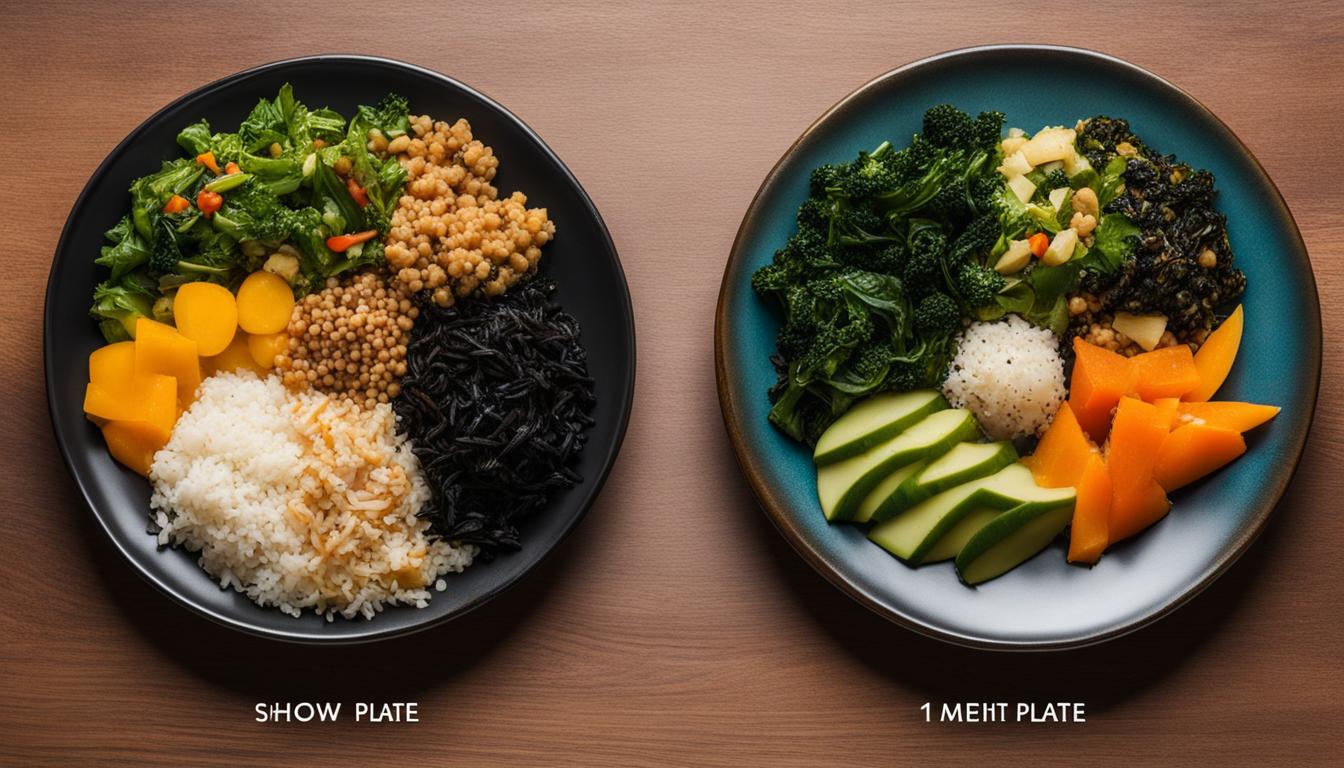With the rise of gluten-free and wheat-free diets, it is easy to confuse the two and assume they are the same. However, there are significant differences between the two, and it is crucial to understand them before making any dietary changes. In this article, we will explore the key differences between a gluten-free and wheat-free diet, their impact on health and lifestyle, and their dietary restrictions.
Key Takeaways:
- A gluten-free diet eliminates gluten, a protein found in wheat, barley, and rye
- A wheat-free diet eliminates wheat specifically, but may still contain other gluten-containing grains
- Following a gluten-free or wheat-free lifestyle can have health benefits, but proper nutrition is essential
- Challenges such as dining out and social situations may arise, but with planning, they can be successfully navigated
Understanding Gluten-Free Diet
A gluten-free diet is a dietary approach that eliminates all foods containing gluten. Gluten is a protein found in wheat, barley, and rye. This diet is often followed by individuals who have celiac disease, a gluten intolerance, or a wheat allergy. It is also popular among people who want to reduce inflammation in their body, manage symptoms of irritable bowel syndrome (IBS), or improve their digestion and overall health.
In a gluten-free diet, all foods that contain wheat, barley, and rye are avoided. This includes bread, pasta, cereal, and baked goods made with wheat flour. However, there are many gluten-free alternatives available such as rice, quinoa, corn, and potato flour. In addition, many gluten-free products are now available in grocery stores, including bread, crackers, and pasta.
Benefits of a gluten-free diet may include relief from digestive symptoms such as bloating, abdominal pain, and diarrhea. It may also improve skin health, reduce inflammation, and promote better nutrient absorption. However, it is important to note that a gluten-free diet can also be lacking in certain nutrients and may be higher in calories, sugar, and fat than a diet that includes gluten.
Navigating a Wheat-Free Diet
A wheat-free diet involves avoiding foods that contain wheat, including bread, pasta, and pastries. This diet is often followed by individuals who are intolerant to wheat or have celiac disease. While similar to a gluten-free diet, a wheat-free diet is not necessarily gluten-free and can still include foods such as barley, rye, and oats.
When looking for wheat-free products, it’s important to carefully read labels and look for alternative grains and flours, such as rice flour, millet, and quinoa. However, it’s important to note that not all gluten-free products are also wheat-free, as they may still contain wheat starch or wheat derivatives.
In addition to wheat-containing foods, those on a wheat-free diet should also be aware of cross-contamination. This can occur when foods are processed or prepared in the same facility as wheat-containing products. To avoid cross-contamination, it’s important to thoroughly clean cooking surfaces and utensils and to be cautious when dining out.
While a wheat-free diet can be challenging, it can also lead to a variety of health benefits. Many individuals who follow a wheat-free diet report improved digestion, increased energy, and reduced inflammation.
If you suspect a wheat intolerance or have been diagnosed with celiac disease, it’s important to consult with a healthcare professional or registered dietitian to ensure you are meeting your nutritional needs.
Key Differences Between Gluten and Wheat
While gluten-free and wheat-free diets may sound similar, they are not interchangeable. Gluten is a protein found in wheat, barley, and rye, while wheat is a grain that contains gluten. Therefore, a gluten-free diet eliminates all sources of gluten, including wheat, barley, and rye, while a wheat-free diet only eliminates wheat-based products.
It is important to note that while gluten is the main culprit behind adverse reactions in individuals with gluten sensitivity or celiac disease, wheat contains other components that may also cause adverse symptoms. For example, some individuals may experience reactions to wheat germ agglutinin, which is present in wheat but not in other grains containing gluten.
Furthermore, while wheat-free products are often labeled as gluten-free, this is not always the case. Gluten can be found in other grains or products that are not necessarily derived from wheat. Therefore, it is important for individuals with gluten sensitivity or celiac disease to carefully read labels and ingredients lists to ensure the products they are consuming are truly gluten-free.
Health Implications and Considerations
A gluten-free or wheat-free diet can have various health implications for individuals who need to follow them due to medical conditions or intolerances. For instance, celiac disease, non-celiac gluten sensitivity, and wheat allergy are some of the common conditions that require a gluten-free or wheat-free diet. A gluten-free diet mainly focuses on eliminating all sources of gluten protein from the diet, which can be found in grains like wheat, barley, and rye.
One of the main considerations for individuals following a gluten-free or wheat-free diet is to ensure they get adequate nutrition. Gluten-free and wheat-free bread and other products can be less fortified with vitamins and minerals than their gluten and wheat-containing counterparts. Therefore, it’s essential to include a variety of nutrient-dense foods such as fruits, vegetables, lean proteins, and whole grains like brown rice, quinoa, and gluten-free oats to compensate for any nutritional gaps.
In terms of gluten-free vs wheat-free bread, gluten-free bread is typically made from grains that naturally do not contain gluten, such as rice, corn, and tapioca. However, it may not provide the same texture and flavor as wheat-based bread. On the other hand, wheat-free bread may still contain gluten from other sources like barley or rye but is free from wheat.
Individuals with celiac disease or non-celiac gluten sensitivity may experience symptoms such as bloating, abdominal pain, diarrhea, and fatigue when consuming gluten-containing foods. A gluten-free diet can help manage these symptoms and improve their overall quality of life. Similarly, individuals with wheat allergy may experience adverse reactions such as hives, swelling, or anaphylaxis, which can be life-threatening in severe cases.
It’s important to note that following a gluten-free or wheat-free diet should only be done under the guidance of a healthcare professional or a registered dietitian. These professionals can help individuals ensure that their dietary intake is balanced and meets their nutritional needs while accommodating their specific dietary restrictions.
Lifestyle and Dietary Restrictions
Following a gluten-free or wheat-free diet can significantly affect an individual’s lifestyle and dietary choices. Here are some key differences between gluten-free and wheat-free diets that can impact one’s day-to-day life:
- Gluten-free products are generally more widely available than wheat-free products.
- Individuals who follow a gluten-free diet must avoid all sources of gluten, including traces of gluten often found in processed foods.
- Wheat-free products may still contain gluten, making it essential to read labels carefully.
- Gluten-free diets are commonly associated with celiac disease and gluten intolerance, while wheat-free diets may be followed by individuals with wheat allergies or sensitivities.
When it comes to dining out or social events, following a gluten-free or wheat-free diet can present challenges. Here are some tips to help navigate these situations:
- Research menu options ahead of time and communicate dietary restrictions to restaurant staff.
- Bring gluten-free or wheat-free snacks to ensure there are safe options to eat.
- Be assertive and communicate needs clearly to hosts or servers when attending social events.
- Connect with local support groups or online communities to share experiences and find resources.
It’s important to remember that, regardless of the reasons behind following a gluten-free or wheat-free diet, proper nutrition should always be a priority. Individuals should aim to consume a balanced diet consisting of fruits, vegetables, lean proteins, and gluten-free or wheat-free whole grains.
By understanding the differences between gluten-free and wheat-free diets, individuals can make informed dietary choices that benefit their health and overall lifestyle.
Conclusion
After exploring the key differences between gluten-free and wheat-free diets, it is clear that they are not interchangeable terms. While both diets require the elimination of certain grains, the reasons and implications are distinct.
A gluten-free diet is necessary for individuals with celiac disease or gluten sensitivity, as consuming gluten can cause severe health problems. On the other hand, a wheat-free diet may be necessary for individuals with wheat allergies or intolerance, which can cause digestive issues.
While following a gluten-free or wheat-free diet can be challenging, it is important to prioritize health and make informed dietary choices. Consultation with a healthcare professional and registered dietitian can help ensure proper nutrition while following these dietary restrictions.
Furthermore, navigating social situations and dining out can be difficult, but it is possible with the right strategies and communication. Informing friends and family and doing research on restaurants with gluten-free or wheat-free options can make these situations more manageable.
In summary, understanding the differences between gluten-free and wheat-free diets can help individuals make informed choices about their health and lifestyle. By prioritizing proper nutrition and communication, individuals can successfully adhere to these dietary restrictions.
FAQ
Q: What is the difference between a gluten-free diet and a wheat-free diet?
A: A gluten-free diet eliminates all sources of gluten, which is a protein found in wheat, barley, and rye. A wheat-free diet, on the other hand, only avoids wheat-based products but may still include gluten-containing grains.
Q: What foods are typically avoided in a gluten-free diet?
A: In a gluten-free diet, foods such as bread, pasta, cereals, and baked goods made with wheat, barley, or rye are avoided. Other gluten-containing ingredients, such as malt, are also excluded.
Q: Why would someone choose a wheat-free diet specifically?
A: Some individuals may choose a wheat-free diet if they have a specific intolerance or sensitivity to wheat. By eliminating wheat, they can still consume other gluten-containing grains like barley and rye.
Q: What are the main differences between gluten and wheat?
A: Gluten is a protein found in wheat, barley, and rye, while wheat is a specific grain that contains gluten. Wheat also contains other components that may cause adverse reactions in some individuals.
Q: How can a gluten-free or wheat-free diet impact one’s health?
A: Following a gluten-free or wheat-free diet can be beneficial for individuals with celiac disease, gluten sensitivity, or wheat allergies. It can help alleviate symptoms and improve overall digestive health.
Q: What are the lifestyle implications and dietary restrictions of a gluten-free or wheat-free diet?
A: Dining out and social situations can pose challenges for individuals following these diets. It’s important to carefully read food labels, communicate dietary needs, and be prepared with alternative options.
 Skip to main content
Skip to main content


